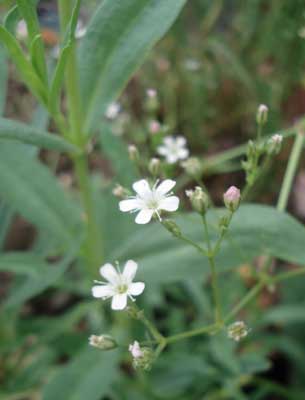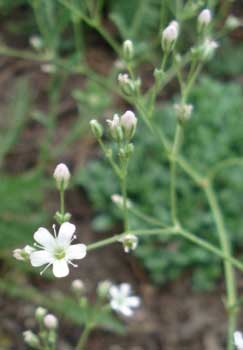
Manchurian Baby's Breath
aka, Oldham's Baby's-breath
"When the bare feet of the baby beat across the grass
The little white feet nod like white flowers in the wind."
-D. H. Lawrence
(1885-1930)
From China, Manchuria, & Eastern Korea, comes this pleasing though not terribly showy garden ornamental, Gypsophila oldhamiana, or Manchurian Baby's Breath.(1885-1930)
The species is named after British botanist Richard Oldham (1837-1864), who collected plants in Japan & China for the herbarium of the Royal Botanic Gardens, though he introduced no live specimens. He died in Taiwan at the young age of twenty-seven.
The root is used in China as a medicinal herb, & to many westerners, the magical phrase "traditional Chinese medicine" is all it takes to gobble down concoctions for which the actual active ingredient turns out to be mercury or amphetamines. A study done in Hong Kong discovered that Chinese herbalists practicing do frequently kill their clients, most often with aconite, but other toxic plants as well, & that's before measuring deaths by diseases that might've been treated more effectively by actual physicians.
 So it's not surprising to discover Gypsophila saponins are sufficiently poisonous to have been used by fishermen to kill fish in streams or ponds. For humans it would take a lot of it for the body to absorb enough to get ill. It's probably not very intelligent to swallow it for a medicine or for any other reason, but neither is it the most dangerous herb in which many a hopeful soul invests their faith & by no means their reason.
So it's not surprising to discover Gypsophila saponins are sufficiently poisonous to have been used by fishermen to kill fish in streams or ponds. For humans it would take a lot of it for the body to absorb enough to get ill. It's probably not very intelligent to swallow it for a medicine or for any other reason, but neither is it the most dangerous herb in which many a hopeful soul invests their faith & by no means their reason.Whether it actually has some capacity to heal anything is a question up for grabs. For true believers in herblore, it most certainly does, though the scientific evidence is iffy. It's a good guess that it's potential to do harm outpaces any possibility of benefit. Extracted saponin, triterpene, steroid, & fatty acid compounds standardized for controllable doses have had favorable preliminary value in attacking cancer cells in mice, though no practical application has yet been made of these chemical compounds. That's not to say some value won't be found.
Unpredicable doses achieved just by pounding & drying the root are used by herbal doctors in China to treat infant malnutrition though it certainly has no special value for this use. It is also given as a treatment for fever, which it allegedly achieves by correcting the patient's yin/yang balance, specifically to correct "yin deficiency." It's definitely more a matter of faith than science, & there's much to be said for yin/yang philosophy, much less to be said for philosophy posing as medicine. Which are fighting words for members of the faith.
The saponins, however, are not much present in the leaves, & in any case quicky break down when heated. So as a culinary herb it is perfectly safe if well-cooked, though in general it is regarded a "famine food" & not to be relied on by discerning palates.
This is a plant that easily absorbs heavy metals when grown in polluted environments, which China's are; it is one of the key species collected for purposes of testing the level of toxicity in polluted soils. When Chinese companies dry the roots to distribute to practitioners of "oriental medicine," they never ever test for harmful contaminants. When these reach the tawdry offices of America's hodgepodge of herbal quacks, all swillers of herbal remedies are truly taking chances.
As an ornamentaql, Manchurian baby's breath is hardy in a variety of conditions. It has been collected from scrubby mountain grasslands, in rocky soil, & in sandy maritime soils. In the garden it prefers full sun, in light sharply draining soil, & is drought-hardy when established.
As a young plant it is inelegant & the flowers so small they hardly make an impact. But as it matures, the sprays of tiny flowers become vastly more numerous & appealing. These are generally white, though strains exist that are pink. It does well as a loose clump amidst upright perennials in a sun-garden, its winding stems reaching up & around other plants to place its flowers in full view. Our one specimen adds its tiny blooms on all sides of nearby achillea & echinacea clumps.